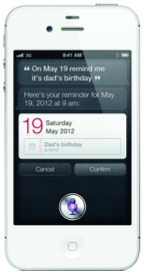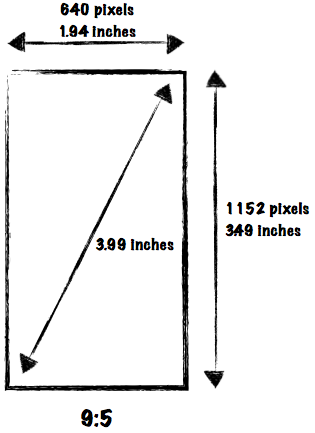In the past year or so the smartphone landscape has seen a trend of screen size increasing from around 3.2/3.5 inches to 4.3, 4.65 and as high as 5.3 inches in the case of the Samsung Galaxy Note. The iPhone screen however, has remained at 3.5 inches since its debut in 2007.
|
 |
 |
 |
|
iPhone 4/4S
960 x 640
3.5 inches
326 ppi |
G1
480 x 320
3.2 inches
180 ppi |
Evo 4G
800 x 480
4.3 inches
217 ppi |
|
 |
 |
 |
|
Galaxy Nexus
1280 x 720
4.65 inches
316 ppi |
Lumia 900
800 x 480
4.3 inches
217 ppi |
Galaxy Note
1280 x 800
5.3 inches
285 ppi |
You could argue that some Android handsets and now the Nokia Lumia 900 were forced to include larger screens as manufacturers raced to accommodate 4G WiMAX and LTE radios. These radios not only take up more room than their 3G counterparts, but also consume a lot more power, leaving no choice but to increase the physical dimensions of the devices to hold the larger circuit board and batteries. Keeping the smaller screens would have been a real waste of space not to mention looked incredibly ugly.
Apple has seldom shown a desire to include new tech in its infancy. The original iPhone famously shipped with just 2.5G Edge data speeds even though 3G had already been widely used for a 2 or 3 years. LTE components are definitely maturing, but there is still lots of room for improvement and optimisation, and LTE networks outside the US are also few and far between.
While the likes of Motorola, HTC, Samsung and others have been pushing LTE equipped mobile devices for well over a year and may be even close to two years now, Apple has only just included this tech in its new iPad (3rd generation). So does this mean the next iPhone (6th generation) will be graced with these uber fast data connections? I'm not 100% convinced. For one the new iPad was given a 70% boost in battery capacity from that of the iPad 2 to power the hungrier radios, though granted a lot of the extra juice is for powering the 2048 x 1536 retina display. The new iPad is also slightly larger to house the bigger power cells and SoC.
Taking all of this into account the conclusion I came to was that for Apple to produce an LTE iPhone, they would need to increase the physical footprint of the device, maybe not significantly but an increase nonetheless. This is something I feel Apple simply won't do, they hit the sweet spot with the physical size of the original iPhone and have not strayed far from those initial dimensions since.
Magic factor
So if Apple won't make the iPhone bigger and hence leave LTE on the cutting room floor for yet another year, what will be the USP for the 2012 model?
Faster CPU? Faster GPU? New form factor? Sure all of these will be welcomed upgrades but its missing the "magic factor", like 3G data speeds with the iPhone 3G, new camera with video recording with the 3GS, retina display and FaceTime with the 4 and 8 megapixel camera with 1080p recording and Siri with the 4S.
So what can possibly be the magic ingredient for the next iPhone? For a long time now many have lusted after a bigger screen for the iPhone. But how could Apple make the screen bigger without making the device any bigger? How would existing apps work and future apps need to be built? And probably most importantly how could the retina quality 300+ ppi be maintained?
Eureka!
I'll be honest with you, I didn't have a clue. But then last week, while watching the Vergecast episode 24, came the Eureka moment. A caller named
Colin (apologies if I got your name wrong) Timothy Collins mentioned how he thought apple could increase the iPhone screen size without effecting the external form factor or pixel density. I will elaborate on this now.
All iPhones have had a 3.5 inch display with 3:2 aspect ratio, and since the iPhone 4 they have had a resolution of 960 x 640. If Apple were to increase the diagonal screen size, what should it be? I think 4 inches is the optimal size. 3.7 isn't really a significant enough bump to justify a change and the earlier mentioned 4.3 and 4.65 inch sizes force the overall device to be simply too big.
So how could you build a 4 inch display for the iPhone?
The solution
The obvious solution people including myself have thought of was to keep the same 960 x 640 resolution but increase the pixel size. This would mean that existing iPhone apps would simply just work with no extra effort from developers. Perfect solution right? Wrong, there are a few flaws with this. Firstly maintaining the same resolution and increasing the screen size to 4 inches would significantly reduce the ppi to 288, thats well below the 300 mark Apple as touted as retina quality. In fact the largest screen size with this resolution that still hits this 300 figure is 3.835 inches, that's still not a big enough bump from 3.5 in my opinion and I doubt Apple is willing to reduce the ppi from the current 326.
Here's where the Verge reader
Colin's Timothy's idea comes into play. Change the aspect ratio. As I mentioned above, all iPhones (and iPod touches) have had an aspect ratio of 3:2. Could Apple change the aspect ratio to increase the screen size while maintaining the same 326 ppi? What aspect ratio would need to be to hit that 4 inch mark? And most importantly how could app fragmentation be avoided?
Colin's Timothy's idea was to keep the shorter side of the iPhones screen the same, i.e. 640 pixels at 1.94 inches. With that in mind how much would the longer side need to increase so the that diagonal measurement was 4 inches. The answer, derived using simple algebraic rearrangement of Pythagorus's theorem, 1152 pixels and 3.49 inches. That leaves the the diagonal length measuring a little over 3.99 inches, I'm sure Apple PR could round this to 4.
For those of you who are good with numbers I'm sure you've noted that 1152 x 640 has an aspect ratio of 9:5 and the 1152 pixels is and increase of 192 from 960 and that's 20% more than on the iPhone 4 and 4S.
But how will iOS cope with the change in dimension and increase in pixels? Well the answer is actually more simple than you might think.
Homescreen
As you can see from the mock up on the right, the extra 192 pixels along the longer side is more than enough to include another row of app icons on the homescreen.
The additional room could persuade Apple to introduce homescreen widgets like those found on Android or even something akin to Windows Phone live tiles. But perhaps this is too much wishful thinking.
Apps
The real challenge of course is how to display apps, both built-in and those from the AppStore. But again I believe a large number of these will require little to no modification to exploit the extra screen real estate.
Built-in apps
Let's tackle the built-in apps first. Apple should have no trouble at all updating the 16 or so apps that come out-of-the-box to work on both the existing 3.5 inch devices as well the the 9:5 4 inch screen. Here are few mock up of how some of the preinstalled apps could look.
Phone.app
|
 |
Messages.app
|
 |
Safari.app
|
 |
Maps.app
|
 |
AppStore apps
A large number of apps from the AppStore utilise standard iOS UI elements like those seen in the built-in apps above. What I mean by this is that they typically consist of a title/navigation bar at the top, a tab/menu bar along the bottom and the main content in the center.
With this in mind the 6th version of Apple's mobile OS could make life easy for developers by auto-magically detecting standard UI based apps and arranging the interface accordingly.
Here's how the officially Twitter and Facebook apps would look.
Twitter.app
|
 |
Facebook.app
|
 |
Games and apps with custom UI elements
Obviously not all apps are built with the standard UI elements. In fact most if not all games have their own custom UI. So how would these apps works on this 9:5 display? Well, I think this is one situation where developers will need to get involved. Without any modifications these apps could simple fill the 960 x 640 pixel in the middle of the screen leaving a 96 x 640 black bar on either side. But with a little input from developers the extra pixels could be utilised.
Here are a couple of examples to illustrate this.
Angry Birds.app
|
 |
 |
Doodle Jump.app
|
 |
Video Playback
The large majority of videos nowadays are encoded at a 16:9 aspect ratio. The 3:2 arrangement on the current iPhone leads to a big compromise needing to be made when viewing video.
To see the entire picture of a 16:9 video from YouTube or iTunes, one has to view it in letterbox mode with 940 x 50 pixel black bars on the top and bottom of the screen when viewing in landscape.
If however, you want to make the video take up the entire screen, you have to sacrifice 640 x 89 virtual pixels on either side of the screen.
So how would these 16:9 videos render on 9:5 screen. Let's take a look.
When you want to view the entire content of the video this time you actually get black bars on the sides. Unlike the 3:2 screen however, these bars are only 7 pixels wide compared to 50 pixels thick ones before.
When the video is zoomed in to fill the whole 9:5 screen the amount of the image that is lost is also less than that with the current iPhone screen. Now we only lose 4 pixel width rows from the top and bottom compared to 89 pixel wide columns from the sides.
Conclusion
I hope I've been able to demonstrate how Apple could potentially increase the iPhone screen size. This would for sure make this particular spec more competitive against other smartphones.
Will Apple actually do this? Well I for one would definitely welcome it. But if I were a betting man I'd have to say "probably.........not". But we live in hope.




















 Maybe Today 18 April is our dates to try this spotify application since this date is set for a press briefing schedule.
Maybe Today 18 April is our dates to try this spotify application since this date is set for a press briefing schedule.
 What is ASLR:
What is ASLR:






 The Indian govt. finally launches the new tablet device, claimed to be the cheapest tablet in the world, named Aakash, which actually was called the HCL Sakshat earlier. It would be available to the college goers as of now, and the prime interest would be on the Engineering students. It is expected with a price tag of $35 but a few sources claim that it would be coming at around $50, which is the cost at which the govt. is ordering the devices in bulk. It aims to link 25,000 colleges and 400 universities through e-learning programme. IBN claims that the tablet would be available in November with a price tag of Rs. 3000, which is still half of the cheapest tablet around with similar configurations. The tablet is being purchased from a company called DataWind in the U.K.
The Indian govt. finally launches the new tablet device, claimed to be the cheapest tablet in the world, named Aakash, which actually was called the HCL Sakshat earlier. It would be available to the college goers as of now, and the prime interest would be on the Engineering students. It is expected with a price tag of $35 but a few sources claim that it would be coming at around $50, which is the cost at which the govt. is ordering the devices in bulk. It aims to link 25,000 colleges and 400 universities through e-learning programme. IBN claims that the tablet would be available in November with a price tag of Rs. 3000, which is still half of the cheapest tablet around with similar configurations. The tablet is being purchased from a company called DataWind in the U.K.








 What can be the causes for a famous website to go offline for a period of time? Normally, we believe that it is due to some changes that might take effect online, so it is for trial for a certain service or product.
What can be the causes for a famous website to go offline for a period of time? Normally, we believe that it is due to some changes that might take effect online, so it is for trial for a certain service or product.
































